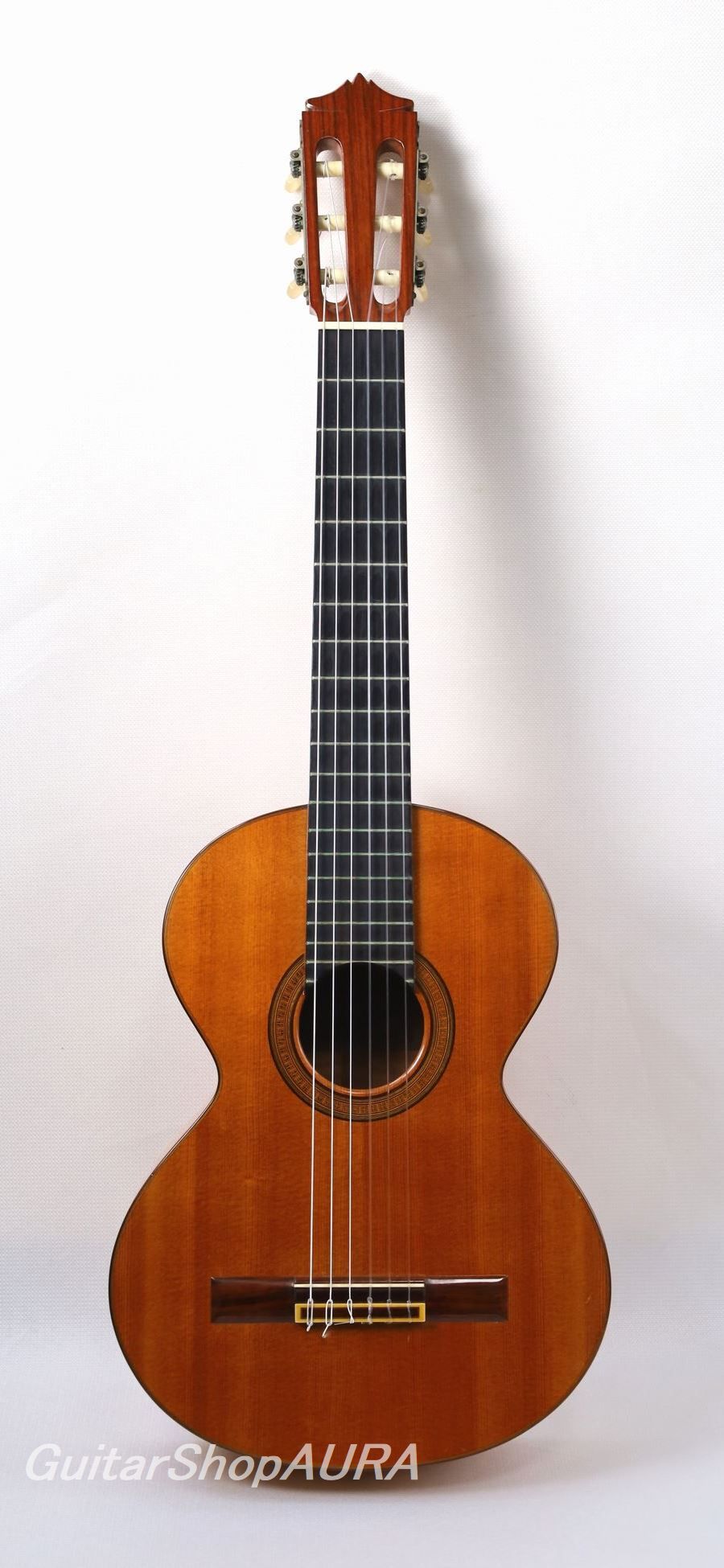
| Instrument | Masaji Nobe |
| Category | Japanese Classical Guitars 〔Vintage〕 |
| Number/Model | No.5 Terz |
| Scale length | 560mm |
| Country | Japan |
| Year | 1969Year |
| Top | Solid Spruce |
| Side&Back | Solid Maple |
| Condition※ | 7 |
| List price | INQUIRE |
| Price (tax included) | Please Inquire |
| option | With Hardcase |
Click to enlarge the photos below
Neck: Mahogany
Fingerboard: Ebony
Finish(Top): Lacquer
Finish(Back & Sides): Lacquer
Tuning Machines: Hofner
String Height(1st): 2.8mm
String Height(6th): 3.5mm
[Luthier Information]
Masaji Nobe (b.1935 – d.2004) was a renowned Japanese luthier born into a family of traditional Edo-era 'sashimono' woodworking artisans. His father, Ikuei Nobe, originally a fine joiner in Tokyo, began repairing guitars using his woodworking skills. This laid the foundation for the Nobe Guitar Workshop.
In 1965, Masaji Nobe established his own workshop, crafting guitars with:
Carefully selected tonewoods
Exceptional craftsmanship
A refined aesthetic deeply rooted in Japanese tradition
His guitars are known for their quiet, dignified visual presence and subtly expressive tonal character—a unique voice that eschews flashiness in favor of mature, contemplative depth. His style is often described as akin to 'seasoned silver'—rich, nuanced, and one-of-a-kind.
His brother Kuniharu Nobe was also a guitar maker. After Masaji’s passing in 2004, his son Masashi Nobe inherited the workshop, using his father’s tools and wood stock to continue the family’s guitar-making legacy. Another son, Seiichi Nobe, also works independently as a luthier and operates a shop specializing in classical guitars, antique instrument repair, and fine furniture.
[Instrument Information]
Masaji Nobe – Terz Guitar – 1969 – No.5 – Used
This is a rare and beautifully aged Terz Guitar by Masaji Nobe, crafted in 1969.
The Terz Guitar, typically tuned a minor third higher than standard tuning (G–C–F–A#–D–G), features a shorter scale length of approximately 530–580 mm and a compact body. Originally popularized in early 19th-century Austria, it was frequently used in ensemble and duet contexts, including works by Mauro Giuliani and Johann Kaspar Mertz. Terz guitars were also favored for their brilliant and articulate tonal qualities, ideal for virtuosic writing of that era.
Though the maker notes this model was inspired by Johann Georg Stauffer (1778–1853), Nobe's execution reflects his own signature approach, not a historical replica. The design, bracing pattern, and construction style follow Nobe’s contemporary guitar-making principles rather than strict period accuracy.
[Bracing & Structural Details]
The soundboard bracing is a modified version of Nobe's standard layout, adapted for the smaller body:
Two harmonic bars (above and below the soundhole)
Reinforcement plates:
One between the neck foot and the upper harmonic bar
One on each side of the soundhole (treble and bass sides)
Three fan braces below the waist
A single transverse bar under the bridge (approximately 1 cm in height, rectangular, higher than the fan braces)
Fan braces pass through the transverse bar and extend toward the lower bout
The overall design reflects Nobe’s typical bracing philosophy, simplified to suit the Terz guitar’s dimensions. The body depth and neck joint are consistent with modern classical guitars, not with 19th-century Viennese construction. As such, this instrument is not a historical recreation, but rather a modern interpretation infused with vintage aesthetics and Nobe’s signature tonal character.
The resonance is set just above C#, appropriate for the Terz tuning and body size.
[Tone & Aesthetics]
Despite its modern internal structure, this guitar possesses a charming, antique-inspired appearance:
Aged spruce top with a warm amber hue
Beautifully flamed maple back and sides
A subtle, earthy aesthetic that matches its soft-spoken but rich tonal profile
Sonically, it offers a focused, bright, and elegant voice—ideal for chamber ensemble use, historical performance, or solo work where a Terz guitar’s unique voice is required.
[Condition]
Considering its age, this guitar is in very good condition:
Top:
Light surface scratches near the fingerboard edge and soundhole
Some small dings above and below the bridge, including a faint 1st-string mark
Back and sides:
Minor friction marks likely from clothing contact
Some finish transitions and faint ridges near seam joints (cosmetic only)
Neck back:
Light nail scratches, not visually prominent or felt during play
There are no structural issues, cracks, or major repairs recorded.
Playability
String action (12th fret):
1st string: 2.8mm
6th string: 3.5mm
Saddle rests on a shim; even with the shim, there is ample remaining saddle height: approx. 3.5–4.0 mm
Neck angle and fret condition are excellent, and the guitar is currently fully playable.
Summary
A unique, boutique example of a Terz Guitar by Japanese master luthier Masaji Nobe, this instrument offers:
Rare craftsmanship by a highly respected luthier
A refined, vintage-like visual and tonal character
Excellent condition and playability for its age
A distinctive addition to any collection of historical or ensemble guitars
It’s an ideal choice for:
Collectors of rare small-bodied guitars
Historically informed performers looking for a non-replica, musically expressive Terz guitar
Players seeking a subtle but characterful voice in a compact format